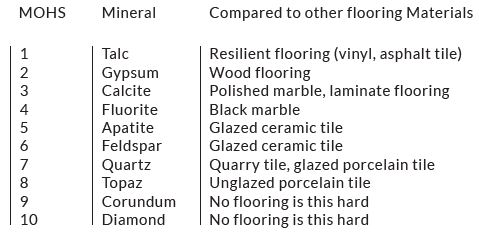The Tile Nutritional Label
What Is The Tile Nutritional Label?
Tile like any other product on in our industry is made from specific ingredients which make up its composition. Just as pizza can be created with different ingredients and with different methods, tile can be too! For example, ceramic tile is made mainly from clay and silica whereas porcelain tile can have a wide array of ingredients such as clay, silica, feldspar, flint, quartz, and even recycled porcelain tiles. Furthermore, ceramic tiles and porcelain tiles are manufactured differently under different temperatures. To make matters even more complicated, porcelain tiles can be manufactured with different ingredients and with different methods. So given that different tiles are made with different raw materials and different manufacturing procedures, you can expect that the final product will have different properties. Hence, the tile’s “nutrition label” is born!
Going back to our pizza example, the ingredients that go into a pizza dictate its salt content, fat content, sugar content, and so on. As consumers, we can use this information to understand how they produced the pizza, and if it’s healthy or not through industry standards. In the same way, the tile’s “nutritional label” also provides insight into its glaze scratch resistance, slip resistance, breakage strength, deep abrasion resistance, water absorption, usability, and so on. At Vela Tile, we are transparent about this label. We want our customers to be informed and help them make the right decision when it comes to buying tile for their home. This information is offered by the manufacturer when they get their tile tested by organizations like ASTM. To buy a quality tile, we recommend you to pay attention to this label just as you should do when you buy food from a store.

Technical Terms On The Label
Definition: Colour body means that the manufacturer has added a dye that closely resembles the colour of at the surface of the tile.
Importance: The importance of this is that if someone ever drops something heavy on the tile and it chips, it’s less likely to show.
Accidents happen, but this is great feature to look for when picking tiles for high traffic areas. Last thing you want to see is an ugly chip spot on a tile if that ever happens. Colour body tiles also look great if the side of the tile is every going to be visible.
Definition: The PEI rating is essentially a measurement of the tile surface glaze’s resistance to abrasion. This measurement applies to glazed tiles.
Importance: It’s important to pay close attention to the PEI class when choosing a tile for a particular application.
Here are the recommended applications of the different PEI classes:
Class 0 – Light duty walls only, never underfoot
Class 1 – Walls of all applications, never under foot
Class 2 – Walls and light duty floors such as residential bathrooms
Class 3 – Residential floors and walls
Class 4 – Residential floors and walls, Medium traffic commercial
Class 5 – Any area residential or commercial
Definition: This term refers to the range of colour or pattern variation to expect on the tile. It ranges from no shade variation that can be detectable by the human eye (V0), to the potentially extremely variation on color, tone, and pattern of a (V4).
Importance: To recognize how much variation to expect on the tiles so that you don’t get surprised and end up thinking either of the following:
- “That is not the tile that I picked!”
- “My newly tiled floor doesn’t look anything like the sample tile.”
V0 – Pieces of the same shade value are very uniform and smooth in texture. They can be measured for small color differences and are in compliance with color uniformity requirements.
V1 – Differences among pieces from the same tile are minimal.
V2 – There are clearly distinguishable differences in texture and/or pattern within similar colors of the tiles.
V3 – While the colors and/or texture present on a single piece of tile will be indicative of the colors and/or texture to be expected on the other tiles, the amount of colors and/or texture on each piece may vary significantly.
V4 – There is substantial variations between tiles. Expect random colour and/or texture differences from tile to tile, so that one tile may have totally different colors and/or texture from that on other tiles. Thus, the final installation will always be unique.
The Shade Variation plays a role in how busy you want the surface to look.
Definition: Ability of the tile to withstand temperatures below zero degrees Celsius.
Importance: This is great to know for installing tile for outdoor use especially in Canada otherwise the tile might crack or easily wear out it’s colour after a cold season.
Definition: Tile is made from minerals. One of the most important tests for identifying the strength of any mineral specimen is the Mohs Hardness Test. This test compares the deep abrasion resistance of a mineral to being scratched by ten reference minerals known as the Mohs Hardness Scale. The test is useful because most specimens of a given mineral are very close to the same hardness. This makes hardness a reliable diagnostic property for a porcelain tile.
Importance: If you are planning to put a tile in a high traffic area or an area that is prone to abrasion, then it’s important to consider the Mohs Hardness Scale of the tile in the selection process.

Definition: Water absorption rates are a measurement of how much moisture a specific type of tile is likely to absorb.
Importance: Some types of tiles may crack if the moisture penetration is too high. Therefore they are not suited for wet environments.
The four different ratings for tile moisture absorption are:
- Non-vitreous (Low density) – Tile with water absorption of more than 7.0 percent
- Semi-vitreous (Medium density) – Tile with water absorption of more than 3.0 percent, but not more than 7.0 percent
- Vitreous (High Density) – Tile with water absorption of more than 0.5 percent, but not more than 3.0 percent
- Impervious (Extremely dense) – Tile with water absorption of 0.5 percent or less. This is where porcelain tile is generally categorized
Note: Porcelain tile is defined by ANSI A137.1 as an impervious tile with a water absorption of 0.5% or less as measured by the ASTM C373 test method.
Definition: People generally slip on wet surfaces or wet shoes, not clean dry surfaces. This is a test that measures the amount of force required to keep an object in motion as it slides over a tile and reflects real life situations where a person might slip on wet tiles.
Importance: This is important to consider when selecting tiles if you are putting tiles in a location that is subject to traffic and exposed to water such as bathrooms or even hallways.
North American Standard – DCOF (Dynamic Coefficient of Friction)
The measurements require that for level floor tiles, wet with water.
Interior Floors: Minimum slip resistance is 0.42 DCOF
Exterior Floors: Minimum slip resistance is 0.60 DCOF
Other situations, such as slope, standing water, oil, grease, or other slippery substances, may require higher DCOF numbers.
The European (ISO) Standard – R rating (ramp test)
This test requires an operator who is protected by a fall restraint harness, and wearing standard footwear, walk backwards and forwards over a sample of a flooring material that has been evenly coated with oil. Beginning with the ramp in a horizontal position, they gradually increases the angle of inclination until the limit of safe walking is reached and the test person slips. The acceptance angle obtained is used to express the degree of slip resistance. The ratings scale goes low to high, R9 – R13.
Definition: Based on various characterists of the tile, some tiles are rated for walls and some are rated for both walls and floors.
Importance: This is great for knowing if a tile is suited for walls and not for floors.
Definition: The country in which the tile was manufactured in. Not to be confused with the tile being designed in a certain country, and then manufactured in a completely different country.
Importance: This is important because different countries set different standards for tile. For example, the tile industry in Italy has high standards for tile produced (which is governed by Certifications that the tile must pass). Italy is known for it’s tile, mountains of marble like the Apuan Alpes, and how many years of experience this country has had in tile manufacturing. This will tell you about the quality you will expect to see.
At Vela Tile, we set high standards on quality because we want our customers to buy the same tile that we would be proud to put in our own home.
This is to do with the effect or the “look” the tile resembles. Technology is improving in the way we manufacture tile. You can now buy tile that resembles the look of marble, or the look of concrete, or the look of wood. This is what we mean by “the look”.
The material refers to the type of tile it is, ceramic or porcelain. These types of tiles have different ingredients and manufactured under different methods.
This measurement refers to how thick the tile is. This is important to know if you want to make your tile flush with another flooring like hardwood. Knowing the thickness of the tile can help you estimate how high or how low the tile will sit relative to your hardwood flooring. Your contractor can then make adjustments to the floor accordingly.
This refers to the dimensions of the tile. For example we can have a 12″ x 24″ tile, sometimes called a 1’x2′ tile.
The format refers mainly to the size category of the tile. Tiles can be small format, large format (any tile with one side bigger than 380mm (15″) or more), plank tile, mosaic tile. Knowing the format of the tile plays an important role in the installation method used to install it. This is important information for your tile contractor.

